Are you staring at those lackluster walls, dreaming of a change but unsure where to begin? Your home’s transformation might be just a paint can away. While the prospect of repainting might seem daunting, it remains one of the most economical and metamorphic ways to breathe new life into any space.
Whether you’re a first-time painter looking to revamp a small bedroom or an enthusiast ready to tackle the entire house, we’ve curated 40 inspiring ideas that blend timeless techniques with contemporary trends.
From creating ethereal effects in your bedroom to bold statements in your living room, each idea has been carefully selected to help you achieve professional-looking results.
Think of this guide as your painting companion, walking you through everything from subtle color transitions to dramatic feature walls. Ready to pick up that brush and transform your space?
Home Painting Ideas
Let’s dive into these creative painting ideas that will help you turn your home into a personalized masterpiece.
Living Room Paint Ideas
1. Two-Tone Wall Division

The two-tone wall technique has become increasingly popular for modern living rooms, offering a sophisticated way to add visual interest without overwhelming the space. This approach involves dividing your wall horizontally, typically at chair-rail height or slightly higher, and using two complementary or contrasting colors. The lower portion often features a darker shade, creating a grounding effect, while the upper section showcases a lighter tone to maintain an open, airy feeling.
For best results, consider using colors from the same family, such as deep navy blue paired with a soft powder blue, or go bold with contrasting colors like charcoal gray and warm beige. This technique works particularly well in rooms with high ceilings and can help make smaller spaces appear larger when executed properly.
2. Accent Wall with Geometric Patterns

Transform your living room with a striking geometric accent wall that serves as the room’s focal point. This modern approach combines careful planning with creative execution, using painter’s tape to create precise shapes like hexagons, triangles, or abstract patterns. The key to success lies in selecting colors that complement your existing furniture and décor while making a bold statement.
When implementing this idea, start with a light base coat and add darker or more vibrant colors for the geometric elements. Popular combinations include soft gray with gold accents, white with deep teal patterns, or beige with charcoal designs. The complexity of your pattern can range from simple diamonds to intricate tessellations, depending on your skill level and desired impact.
3. Color Blocking with Bold Hues

Color blocking brings a playful yet sophisticated element to living room walls, perfect for those who want to make a modern artistic statement. This technique involves painting distinct sections of your walls in different colors, creating visual blocks that can highlight architectural features or create new focal points within the room.
The secret to successful color blocking lies in choosing the right color combination and maintaining clean, crisp lines between each block. Consider using three to four colors maximum, ensuring they work harmoniously together. Popular combinations include mustard yellow, navy blue, and coral, or emerald green, blush pink, and cream for a softer approach.
Bedroom Paint Ideas
4. Calming Ombré Effect

Create a serene sleeping environment with an ombré wall effect that gradually transitions from one color to another. This sophisticated painting technique works exceptionally well in bedrooms, where it can promote relaxation and visual interest without being overwhelming. The key is to choose colors that flow naturally together, such as light blue to navy or pale pink to deep mauve.
The technique requires patience and careful blending, but the results can be stunning. Start with the lighter color at the top of the wall and gradually blend it into the darker shade as you move downward. This creates a soothing watercolor effect that can make your ceiling appear higher while adding a dreamy quality to your bedroom.
5. Textured Accent Wall

Add depth and sophistication to your bedroom with a textured accent wall behind the headboard. This technique involves using specialized paint tools or techniques to create patterns that catch light and shadow throughout the day. Popular textures include subtle stripes, grasscloth effects, or gentle stippling patterns that add visual interest without overwhelming the space.
To execute this idea effectively, choose a paint color that’s either a few shades darker or lighter than your other walls. The texture will create natural shadows and highlights, so the color you select should complement both your bedding and the room’s overall color scheme. Consider using metallic paint for added glamour, or stick with matte finishes for a more understated look.
6. Night Sky Feature Wall
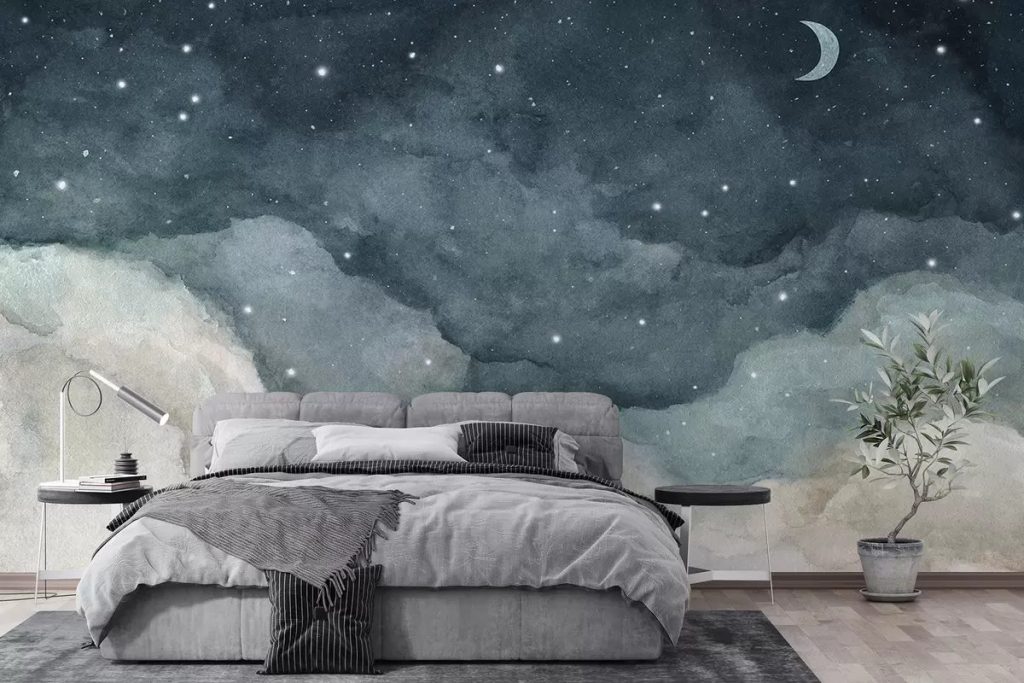
Transform your bedroom ceiling or walls into a mesmerizing starry night sky using specialized paint techniques. This enchanting design combines deep blue or black base paint with subtle metallic accents to create a cosmic atmosphere perfect for dreaming. The key lies in layering different paint finishes to achieve depth and dimension in your celestial scene.
Execution requires starting with a dark base coat and carefully adding lighter elements using specialized brushes or sponges. Consider incorporating glow-in-the-dark paint for stars that actually twinkle when the lights go out, or use metallic silver paint to create constellations and celestial bodies that catch the light during the day.
Quick Tip: Test paint swatches at different times over 24 hours to see how light changes affect the color
7. Zen-Inspired Color Palette

Create a peaceful sanctuary with a carefully curated color scheme inspired by Japanese zen gardens. This approach focuses on natural, earthy tones that promote relaxation and mindfulness. The palette typically includes soft greiges, warm taupes, and gentle sage greens that work together to create a harmonious environment.
The application should focus on even, smooth coverage with minimal contrast between walls. Consider adding subtle texture through specialized painting techniques that mimic natural materials like stone or sand. This creates a multi-dimensional look while maintaining the serene atmosphere essential for a restful bedroom.
Kitchen Paint Ideas
8. Two-Toned Cabinet Transformation

Revitalize your kitchen by painting upper and lower cabinets in complementary colors. This modern approach adds visual interest while maintaining a cohesive look. Popular combinations include white upper cabinets with navy lower cabinets, or light gray uppers with deep green lowers, creating a balanced and sophisticated appearance.
The success of this technique lies in proper preparation and paint selection. Use high-quality cabinet paint that can withstand frequent cleaning and moisture exposure. Consider the room’s natural light and existing elements like countertops and backsplash when selecting your color palette to ensure a harmonious overall design.
9. Statement Kitchen Island

Turn your kitchen island into a stunning focal point by painting it in a bold, contrasting color. This technique works particularly well when the surrounding cabinets are neutral, allowing the island to become a true centerpiece of your kitchen design. Rich jewel tones like emerald green, sapphire blue, or deep burgundy can create dramatic impact.
When selecting your island color, consider both your kitchen’s color scheme and the overall style of your home. The paint finish is crucial here – a satin or semi-gloss finish not only looks elegant but also provides the durability needed for this high-traffic area.
10. Color-Blocked Pantry Door

Transform your pantry door into an artistic statement piece using color-blocking techniques. This approach allows you to incorporate multiple colors in a geometric pattern that adds visual interest to an often-overlooked area. The design can be as simple as diagonal stripes or as complex as an abstract composition.
The key to success is using high-quality painter’s tape to create crisp lines and choosing colors that complement your kitchen’s existing palette. Consider using three to four colors maximum to maintain a cohesive look without overwhelming the space.
Bathroom Paint Ideas
11. Spa-Inspired Serenity
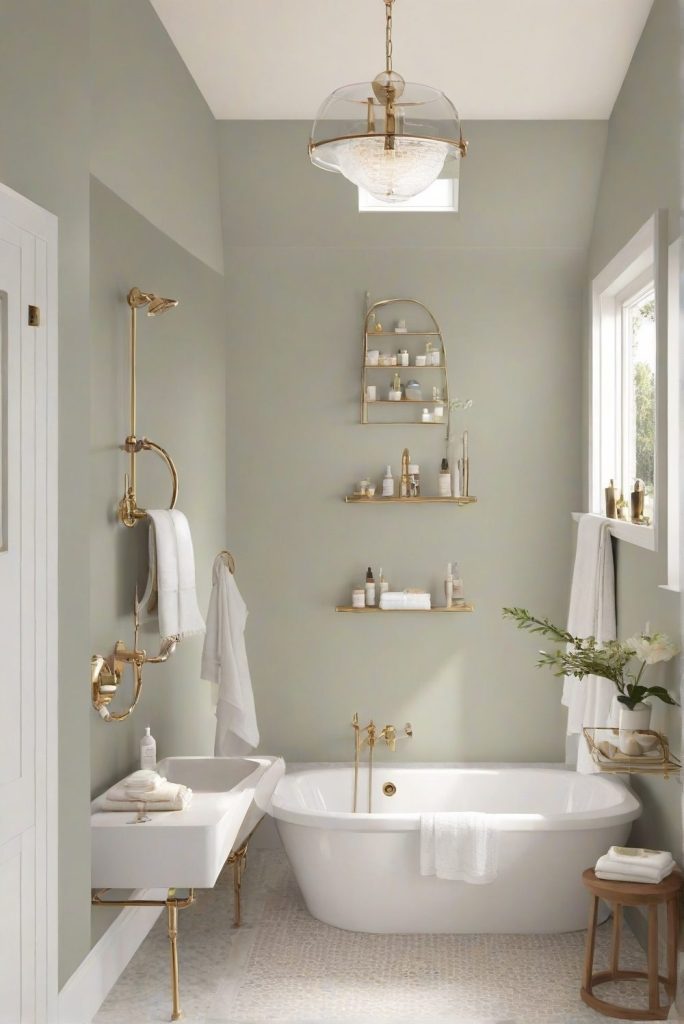
Create a luxurious spa-like atmosphere in your bathroom using soft, tranquil colors that promote relaxation. Pale blues, gentle greens, and warm grays work beautifully in bathrooms, especially when paired with white fixtures and natural materials. The goal is to create a peaceful retreat that feels clean and refreshing.
When painting a bathroom, it’s crucial to use moisture-resistant paint with a mildew-resistant finish. Consider using a semi-gloss finish, which not only adds a subtle sheen but also stands up better to humidity and frequent cleaning. Pay special attention to proper ventilation during and after painting to ensure the best results.
12. Bold Powder Room Drama
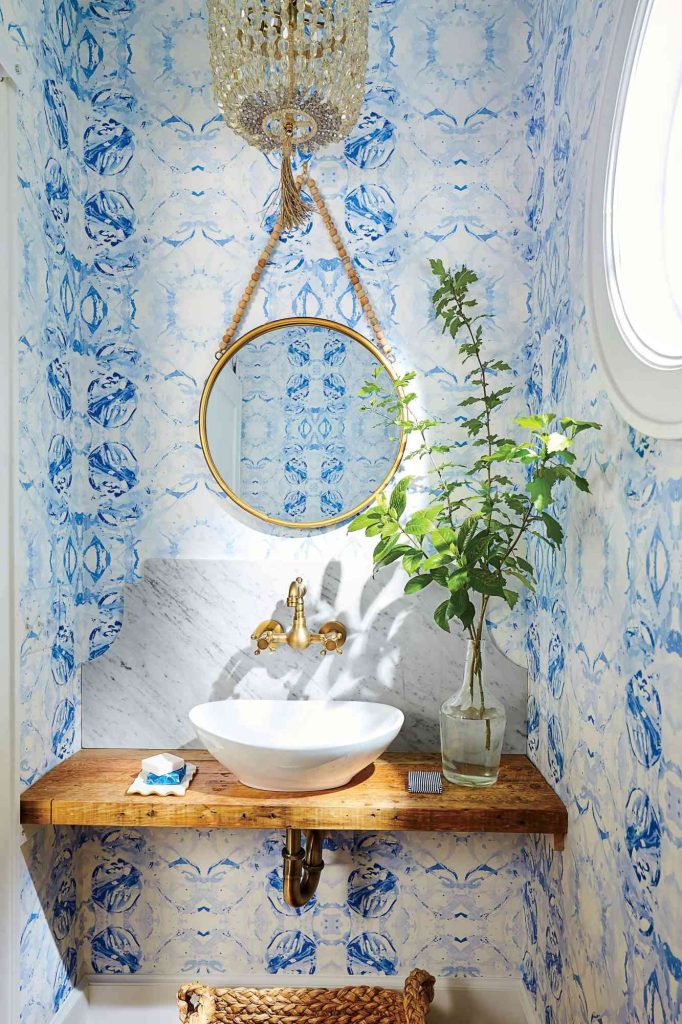
Transform a small powder room into a jewel box by using deep, rich colors or dramatic patterns. Since powder rooms are typically smaller and used less frequently than main bathrooms, they’re perfect spaces to experiment with bold design choices. Consider deep emerald green, rich burgundy, or even black for a truly dramatic effect.
The key to making bold colors work in a small space is to ensure proper lighting and consider using metallic accents or high-gloss finishes to reflect light. Consider painting the ceiling in the same color as the walls for a cocooning effect that makes the small space feel intentional and luxurious.
Creative Painting Techniques
13. Modern Sponge Painting

Reimagine the traditional sponge painting technique with a contemporary twist. Instead of the dated, heavily textured look of the past, modern sponge painting creates subtle, almost watercolor-like effects using monochromatic colors or closely related shades. This technique adds depth and interest without overwhelming the space.
The success of modern sponge painting lies in using natural sea sponges and maintaining a light touch. Work in small sections, building up layers gradually until you achieve the desired effect. This technique works particularly well in transitional spaces like hallways or as an accent wall in a bedroom.
14. Strié Technique
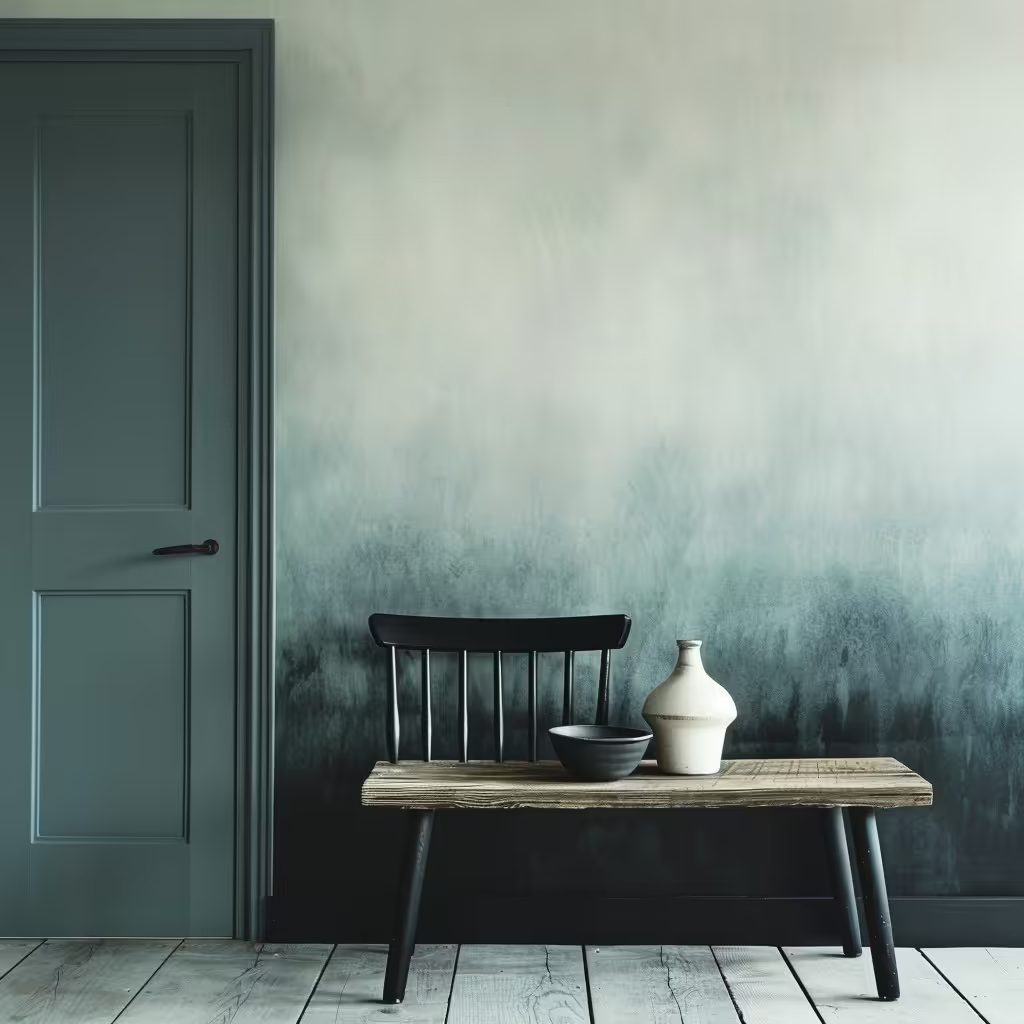
Create elegant, fabric-like walls using the strié technique, which mimics the look of fine linen or raw silk. This sophisticated approach involves applying a glaze over a base coat and using special brushes to create subtle vertical or horizontal lines. The result is a refined, textured appearance that adds depth without being overly dramatic.
The key to successful strié lies in choosing complementary colors for your base coat and glaze. The difference between the colors should be subtle – typically staying within the same color family but varying the shade by just a few levels. This creates a sophisticated, tailored look perfect for formal dining rooms or master bedrooms.
15. Brushed Pattern Effect

Create custom wall patterns using brushed techniques that mimic wallpaper designs. This approach allows for unique, personalized patterns while maintaining the ease of paint maintenance. Using various brush sizes and techniques, you can create everything from subtle stripes to more complex medallion patterns.
The success of this technique relies on careful planning and patience. Start by creating a small test area to perfect your technique before tackling the entire wall. Consider using paint with different sheens – such as combining flat and semi-gloss finishes in the same color – to create subtle pattern variations that change with the light.
Color Theory and Room Psychology
16. Mood-Enhancing Color Schemes

Understanding how different colors affect mood and behavior is crucial when selecting paint colors for specific rooms. Cool blues and greens promote relaxation and are excellent choices for bedrooms and bathrooms. Warmer yellows and oranges energize spaces, making them ideal for kitchens and home offices.
Consider the room’s primary function when selecting colors. For example, deep purples and rich browns can create a sense of luxury and sophistication in a dining room, while light, airy colors can make a small home office feel more spacious and conducive to productivity.
Related Guide: 40 Must-Try Vintage Bedroom Decor Ideas
17. Light-Responsive Paint Selection

Choose paint colors that work with your room’s natural light throughout the day. South-facing rooms tend to receive warm light and can handle cooler paint colors, while north-facing rooms might benefit from warmer tones to counteract cooler light. Test paint samples at different times of day to ensure the color maintains its appeal in varying light conditions.
Consider how artificial lighting will affect your chosen colors as well. Different types of bulbs can dramatically impact how paint colors appear – LED lights might bring out different undertones than incandescent or fluorescent lighting. Always test your paint colors under both natural and artificial lighting conditions.
Special Considerations
18. Small Space Optimization

Make small spaces appear larger through strategic paint choices and techniques. Light colors generally make rooms feel more spacious, but don’t feel limited to white. Soft grays, pale blues, and gentle greens can all create an open feeling while adding more interest than plain white.
Consider painting the ceiling the same color as the walls in small rooms to eliminate the visual break between wall and ceiling, creating the illusion of higher ceilings and more space. Using a slightly lighter shade on the ceiling can achieve a similar effect while maintaining some traditional contrast.
19. Open Floor Plan Coordination
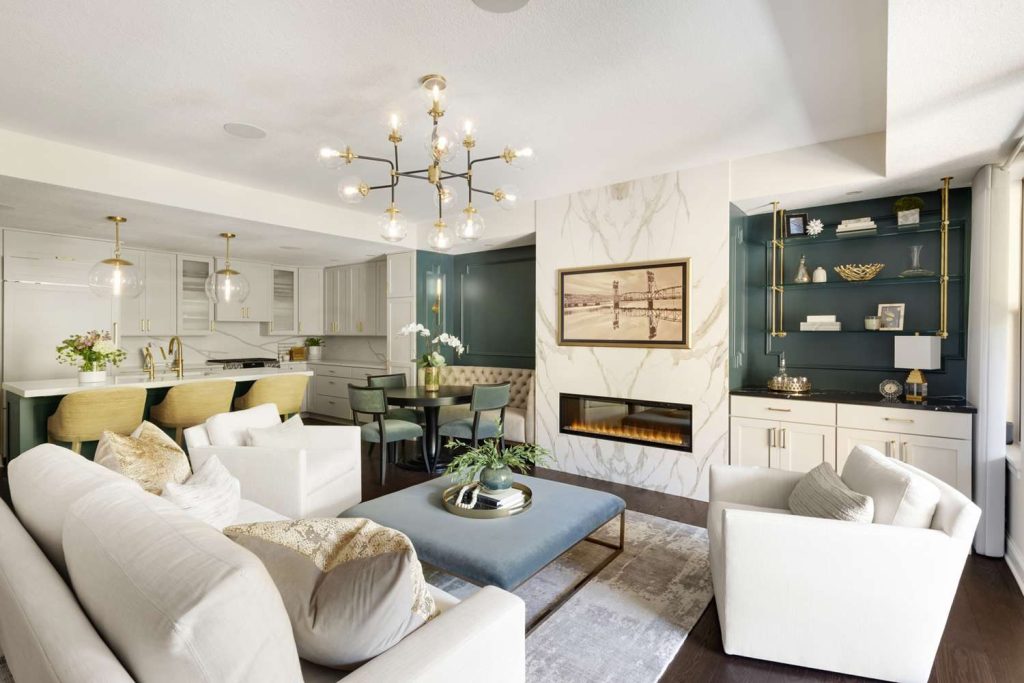
Create a cohesive look in open floor plans by carefully coordinating paint colors between spaces. Use a single color as your base and introduce complementary colors in adjacent areas. This creates visual flow while still defining separate functional spaces.
The key is to choose colors from the same temperature family – either all warm or all cool tones. Consider using darker or lighter versions of the same color to create subtle transitions between spaces while maintaining unity throughout the open floor plan.
20. High-Traffic Area Solutions

Select durable paint finishes for areas that see frequent use or contact. Hallways, mudrooms, and children’s play areas require paints that can withstand cleaning and wear. Semi-gloss or satin finishes are ideal for these spaces as they’re easier to clean and more resistant to scuffs and marks.
Consider using washable paint formulations specifically designed for high-traffic areas. These paints often contain special polymers that make them more resistant to staining and easier to clean without damaging the finish. Some brands even offer specific children’s room formulations that are both durable and low in VOCs.
21. Statement Ceilings

Transform your rooms by treating the ceiling as your fifth wall. The often-overlooked ceiling presents an excellent opportunity to add unexpected color and pattern to any space. Bold geometric designs, subtle metallic finishes, or even deep solid colors can turn a basic ceiling into an architectural feature.
Consider using deep, rich colors for dining room ceilings to create an intimate atmosphere, or try pale blue in bedrooms to mimic the sky. The key is ensuring proper lighting to showcase your ceiling treatment and selecting colors that complement your wall color and room furnishings.
22. Vintage Color Revival
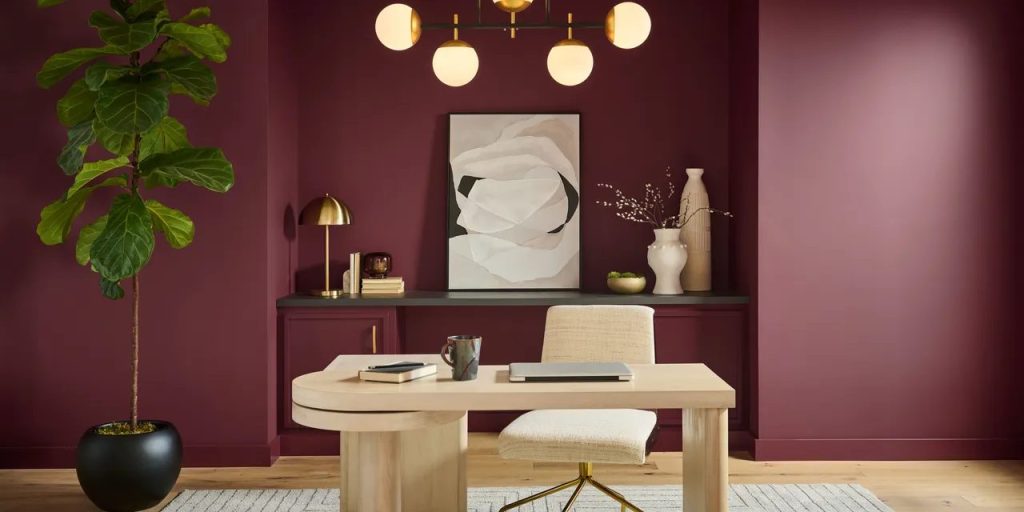
Embrace historical color palettes with a modern twist to create unique and sophisticated spaces. Traditional colors like sage green, colonial blue, or burgundy can be updated by pairing them with contemporary furnishings and accessories. This approach works particularly well in older homes where you want to honor the architecture while maintaining a fresh feel.
The success of vintage colors lies in their application and context. Consider using historical colors in unexpected ways, such as painting traditional wainscoting in a bold heritage color while keeping walls neutral, or using vintage-inspired colors in modern color-blocking patterns.
23. Minimalist Color Schemes

Create serene, sophisticated spaces using carefully curated minimalist color palettes. This approach focuses on subtle variations of neutral colors, using texture and finish to add interest rather than bold color contrasts. Popular choices include warm whites, soft grays, and pale beiges combined in thoughtful ways.
The key to successful minimalist color schemes lies in choosing colors with similar undertones and varying the paint finish to create subtle dimension. Consider using flat paint on walls with eggshell or satin finish on trim to create subtle contrast without introducing new colors.
24. Color Drenching
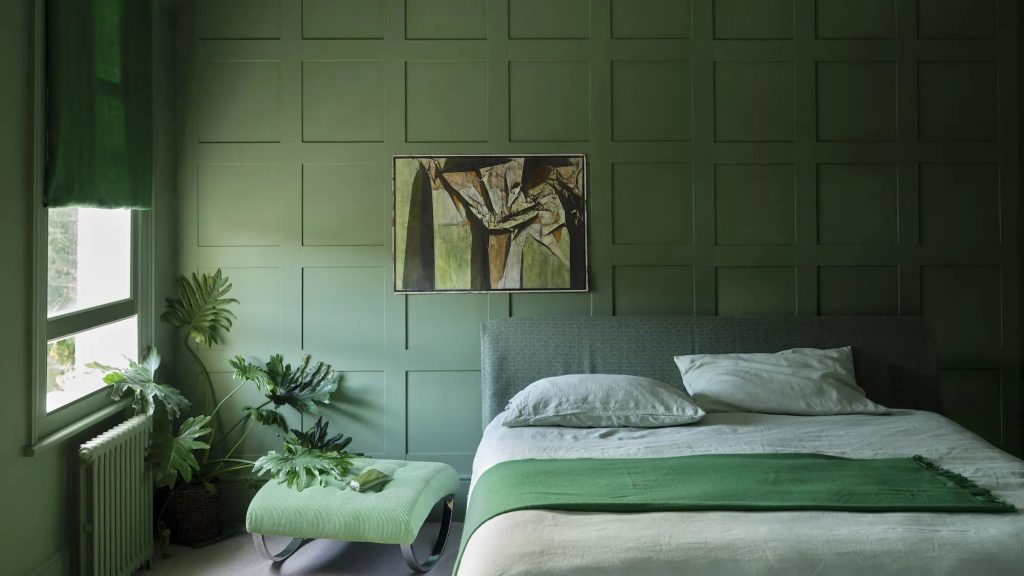
Embrace the bold technique of color drenching, where a single color is used across all surfaces in a room, including walls, trim, and ceiling. This contemporary approach creates a cocooning effect that can make spaces feel both larger and more intimate simultaneously.
Success with color drenching requires choosing the right color intensity and maintaining consistency in application. Deep jewel tones create drama, while softer, muted colors can create a more subtle, sophisticated effect. Consider varying the paint finish between surfaces to add subtle dimension.
25. Painted Door Details

Transform interior doors into artistic statements by using creative painting techniques. From color blocking to ombré effects, doors present perfect opportunities for adding unexpected color and pattern to your spaces. Consider painting both sides of the door in different colors to create surprise elements as people move through your home.
Door painting requires careful preparation and high-quality paint to ensure durability. Consider using semi-gloss or gloss finishes for easy cleaning and maintenance, and don’t forget to properly prime the surface for the best results.
26. Architectural Enhancement

Use paint to highlight or create architectural features where none exist. This technique can involve painting faux moldings, creating the illusion of wainscoting, or emphasizing existing architectural elements through strategic color placement.
The key to successful architectural enhancement lies in careful planning and precise execution. Use painter’s tape to create clean lines, and consider using different paint finishes to enhance the illusion of depth and dimension in your painted architectural elements.
27. Pattern Play with Paint

Create custom patterns using paint to mimic the look of expensive wallpaper. From simple stripes to complex geometric designs, painted patterns can add personality and style to any room. This approach allows for complete customization of both pattern and color while maintaining the ease of paint maintenance.
Successful pattern creation requires careful planning, precise measurements, and patience during execution. Consider using laser levels and high-quality painter’s tape to ensure straight lines and clean edges in your patterns.
28. Gradual Color Transitions

Create subtle color transitions between rooms to maintain flow throughout your home. This technique involves choosing colors that share similar undertones or gradually shifting from lighter to darker shades as you move through spaces.
The success of color transitions depends on understanding color theory and how different colors relate to each other. Consider creating a color map of your home to ensure a cohesive progression from room to room.
29. Painted Furniture Integration

Coordinate painted furniture with wall colors to create cohesive room designs. This can involve painting furniture in complementary colors to your walls or using the same color in different finishes to create subtle variation.
When painting furniture, proper preparation and the right type of paint are crucial for durability. Consider using furniture-specific paints or adding protective topcoats to ensure your painted pieces withstand daily use.
Pro Tip: Use white vinegar in your paint roller tray to extend the life of latex paint while working.
30. Textured Paint Applications

Experiment with textured paint techniques to add dimension to your walls. From subtle sandstone effects to more dramatic stucco-like finishes, textured paint can add visual and tactile interest to any space.
Success with textured paint applications requires choosing the right tools and materials for your desired effect. Consider practicing your technique on sample boards before tackling entire walls.
31. Color Zoning

Use paint to define different functional areas within larger spaces. This technique is particularly useful in open-plan living areas or multi-purpose rooms where you want to create distinct zones without physical barriers.
The key to successful color zoning lies in choosing colors that work together while still providing enough contrast to define separate areas. Consider using different shades of the same color for a subtle approach to zoning.
Related Guide: 40 Inspiring Ideas for Girls Bedroom
32. Light Reflective Finishes

Maximize natural light in your spaces by using paint with light-reflective properties. These specialized finishes can help brighten dark rooms and make small spaces feel larger. Consider using these finishes in north-facing rooms or spaces with limited natural light.
When working with light-reflective finishes, proper surface preparation is crucial for achieving the best results. Consider using appropriate primers and applying multiple thin coats for optimal light reflection.
33. Bold Trim Treatments

Break from traditional white trim by experimenting with colored trim options. This can involve painting trim darker than walls for a contemporary look or using bright accent colors to create unexpected visual interest.
The success of bold trim treatments depends on choosing colors that complement your wall color while providing enough contrast to define architectural details.
34. Faux Finish Effects

Create sophisticated faux finishes that mimic expensive materials like marble, wood, or leather. These techniques can add luxury and interest to your spaces without the cost of natural materials.
Successful faux finishing requires patience and practice to achieve realistic results. Consider taking a class or watching detailed tutorials before attempting complex faux finish techniques.
35. Child-Friendly Color Schemes

Design colorful spaces that grow with children by choosing sophisticated color combinations that appeal to both children and adults. This might involve using bright colors in unexpected ways or incorporating playful patterns that can be easily updated.
Consider using washable paints in children’s spaces and creating designs that can be modified as children’s tastes change.
36. Natural Light Enhancement

Choose paint colors and finishes that work with your home’s natural light patterns. This involves understanding how light changes throughout the day and selecting colors that maintain their appeal in different lighting conditions.
Success requires testing paint samples at different times of day and considering how seasonal light changes might affect your color choices.
37. Multi-Functional Space Solutions

Use paint to help define areas in rooms that serve multiple purposes. This might involve using color to separate work areas from relaxation spaces or creating visual boundaries in shared rooms.
Consider how different colors can help signal different functions within the same space while maintaining overall room cohesion.
38. Seasonal Color Adaptation
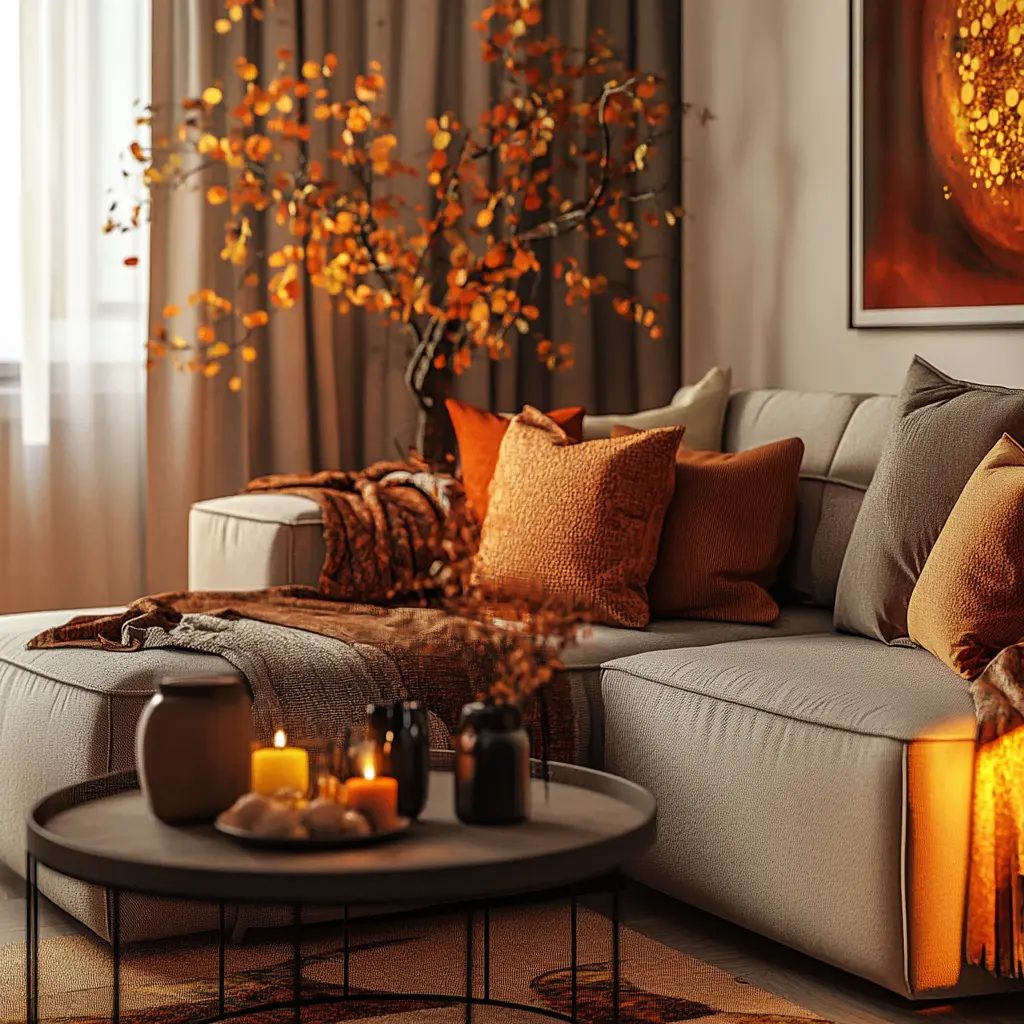
Choose paint colors that work well across all seasons. This might involve selecting neutral bases that can be accessorized differently throughout the year or choosing colors that maintain their appeal regardless of seasonal changes.
Consider how natural light changes across seasons will affect your color choices and how your selected colors will work with different seasonal decorations.
39. Colorful Storage Solutions

Use paint to transform storage spaces and organizational systems. This might involve painting the inside of closets in surprising colors or using color coding for storage solutions.
Consider using durable, washable finishes in storage areas and choosing colors that make items easy to locate and organize.
40. Sustainable Paint Choices

Select eco-friendly paints and application techniques that minimize environmental impact. This involves choosing low-VOC or zero-VOC paints and considering the lifecycle impact of your paint choices.
Research different eco-friendly paint options and consider how your choices affect both indoor air quality and environmental impact.
Conclusion
Transforming your home through paint is one of the most cost-effective and impactful ways to refresh your living space. These 40 painting ideas offer a comprehensive guide to creating unique and personalized environments throughout your home.
Whether you’re drawn to bold statements or subtle sophistication, there’s a painting technique or color scheme that can help you achieve your desired atmosphere. Remember that successful painting projects require proper planning, preparation, and patience.
By carefully considering color psychology, lighting conditions, and practical requirements, you can create spaces that not only look beautiful but also enhance your daily living experience. Take time to test colors, practice techniques, and prepare surfaces properly to ensure the best possible results in your home painting projects.

